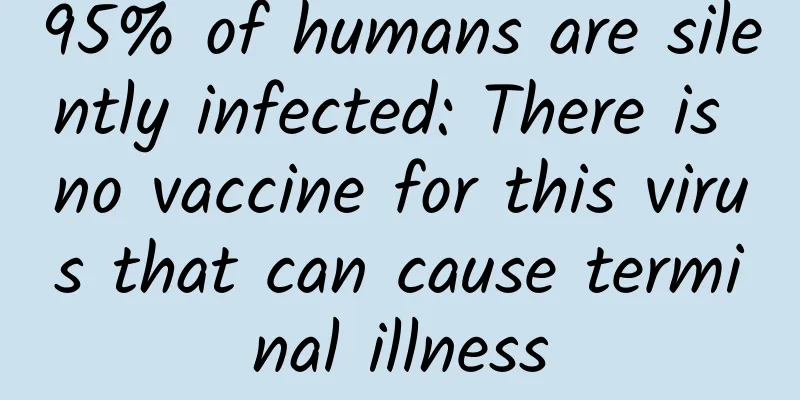95% of humans are silently infected: There is no vaccine for this virus that can cause terminal illness

|
Statistically speaking, the Epstein-Barr virus (also known as human herpesvirus-4) is lurking in your body right now. 95% of the world's population has it. The virus is spread through saliva, so maybe you first got it as a baby from your mother, who got it from her mother, or you might have gotten it at daycare, or from a friend who shared a bottle of Coke with you, or through kissing. If the latter scenario infected you as a young person, the EBV could cause infectious mononucleosis, also known as the "kissing disease," in which a massive immune response against the pathogen causes weeks of sore throat, fever, and fatigue. Copyright image, no permission to reprint The older you are when you are infected with EBV, the more severe the symptoms are. We don't know why yet, but this is not uncommon in the viral world. If, like most people, you were infected as a baby or young child, your initial symptoms were mild enough to be unnoticeable, if not asymptomatic. So, this virus has been keeping a low profile and has infected almost the entire planet. Sometimes people jokingly call it the "everyone virus." Once it enters the human body, the EBV will hide in the cells and accompany you throughout your life. Most of the time, the virus is mild and harmless. However, there are always exceptions. Since its discovery in 1964, EBV has not only been shown to cause infectious mononucleosis, but has also been clearly linked to head and neck cancer, blood cancer, and gastric cancer. More controversially, EBV is also associated with some autoimmune diseases. Two independent studies published in 2022 both clearly stated that EBV is the causative agent of multiple sclerosis, a terminal illness that has no cure to date. In some people, infection is barely detected, while in others, infection leads to chronic, life-threatening illnesses. Why does EBV cause such dramatic differences in the fate of its human hosts? The virus that accompanies us throughout our lives Since the day the EB virus was discovered, it has confused our inherent concept of viruses. The first person to suspect the existence of EBV was Denis Burkitt, a British surgeon working in Uganda who had the "heroic" idea that the abnormal jaw tumors he often saw in local young children were caused by an unknown pathogen. These tumors grow quickly, doubling in size within 24 to 48 hours, and are filled with white blood cells, or lymphocytes, that have become cancerous. The disease came to be known as Burkitt's lymphoma. Burkitt suspected a pathogen because the jaw tumors always spread from one area to neighboring areas and followed a seasonal pattern of spread. In other words, the lymphoma looked like an infectious disease. Copyright image, no permission to reprint In 1963, a biopsy of cells from a girl with Burkitt’s lymphoma made its way to the London lab of British virologist Anthony Epstein. His student, Yvonne Barr, helped prepare the sample. Under an electron microscope, they saw a distinctively shaped herpes virus—a family that also includes the viruses behind genital herpes, cold sores, and chickenpox—filled with tumor cells. Case closed? Not yet. At the time, the idea that viruses could cause cancer was “quite a minority idea.” “There was a lot of skepticism,” says Alan Rickinson, a cancer researcher who worked in Epstein’s lab in the 1970s. Plus, the virus’s ubiquity made the situation confusing. Children with Burkitt’s lymphoma had antibodies to EBV, critics pointed out, but so did other healthy children in Africa. That was unquestionable. So did American children, farmers in faraway Iceland, and remote tribesmen in the Brazilian rainforest. The viruses that scientists examined were found all over the world, and Burkitt’s lymphoma occurred mostly in equatorial Africa. Was it possible that EBV was just an innocent bystander? Why didn’t the virus cause disease elsewhere in the world? This virus, which almost everyone carries, does cause disease, but scientists didn't know where to check until they were directed. In 1967, a technician studying Epstein-Barr virus and cancer in a Philadelphia laboratory fell ill and showed symptoms of infectious mononucleosis. She was one of the very few people who had tested negative for Epstein-Barr virus antibodies before, so she regularly donated blood to the laboratory to provide known negative samples. When she recovered and returned to work, her antibody test turned positive, extremely positive. This hinted at what we know today: Epstein-Barr virus is the most common cause of infectious mononucleosis. Copyright image, no permission to reprint Eventually, scientists discovered more links between the virus and other cancers: nasopharyngeal cancer, stomach cancer, Hodgkin lymphoma, and other forms of lymphoma have all been linked to EBV. All told, it's responsible for 1.5% of cancer cases worldwide. The first two cancers to be caused by EBV infection arise in cells of the throat and stomach, while the others affect white blood cells, or lymphocytes, which are specifically infected by EBV, especially B cells. You know, every B cell in our body is born to recognize a different imaginary enemy. If a particular B cell never finds an "enemy" that matches itself, it will die, and our body will ruthlessly eliminate it as a useless immune cell. If the B cell does find a matching "enemy", it will split and transform into a memory B cell, which will accompany humans throughout their lives, always guarding the body and resisting infection. The genius of the EBV is that it exploits this normal process. It manipulates infected B cells into thinking they have been activated, so they then transform into long-lived memory B cells, where the virus hides for decades. This is a special ability shared by the herpes virus family, such as the chickenpox virus, which hides in nerve cells and causes shingles in its carriers when the time is right. Occasionally, the EBV emerges from hiding to replicate itself, producing just enough copies to keep it alive—not so few that the immune system kills it before it finds another host, but not so many that it harms its current host. The virus and the immune system are in a stable equilibrium, keeping each other in check. “It’s a long-term relationship between a virus and its host, and it’s quite elegant,” says Sumita Bhaduri-McIntosh, an EBV virologist and infectious disease physician at the University of Florida. Once this balance is disturbed, one possible result is cancer. As part of its manipulation of infected cells, the EBV appears to suppress the cells' normal death process. If the cells that refuse to die have other abnormal characteristics, then a person will develop a cancer like Burkitt's lymphoma. "In most cases, when the virus shows up in this cancer, it will later appear in other cancers. It is a link in the chain," said Rickinson. "Obviously it is not the only growth driver." This also explains why the EBV does not give cancer to everyone it infects, only those who are unlucky enough to also acquire other mutations and other misconfigurations. In the case of Burkitt's lymphoma, the cancer cells have also had strange chromosomal rearrangements, which scientists have learned are related to malaria infection. This explains the unique geographical pattern Burkitt observed: EBV is everywhere, but Burkitt's lymphoma is common in areas where malaria is prevalent. Today, EBV is known to be the first human virus associated not only with immediate disease progression, but also with cancers that can develop years after the initial infection. It challenges the traditional paradigm that viruses trigger immunity in the short term and cause disease. After all, it stays in our bodies, interacting continuously with our immune system throughout our lives. Cause terminal illness Over the years, more and more signs of EBV's unusual abilities have emerged. The virus or its antibodies seem to be preferentially present in people with autoimmune diseases such as rheumatoid arthritis, systemic lupus erythematosus, and multiple sclerosis, as well as in patients with chronic fatigue syndrome. The biology of these chronic diseases is more elusive than that of cancer, making them particularly difficult to study. The relationship between EBV and these diseases is still only suggestive, not yet clear. These patients may all carry EBV, but so do all healthy people. "You have 95% of the world's population in the control group, which is not a good start for an epidemiological study," said Paul Farrell, an EBV researcher at Imperial College London. Copyright image, no permission to reprint The latest study by Alberto Ascherio, an epidemiologist at Harvard University, solved this problem by examining a large number of human serum samples collected by the US Department of Defense over more than 20 years (originally used to test for HIV). Using blood samples from 10 million adults, researchers successfully found a group of people who were initially EBV-negative but were infected over a 20-year period, and their likelihood of developing multiple sclerosis increased by 32 times. A second study from Stanford University added a possible causal relationship to this correlation: some patients with multiple sclerosis have an antibody that can bind to EBV proteins and also recognize a class of brain proteins that are mistakenly attacked by the immune system in multiple sclerosis. Scientists have long suspected that such cross-talk exists, but it has not been confirmed until today. "It's like a huge information volcano," said Rickinson of the recent research. However, as with EBV-related cancers, only a small number of people infected with the virus will eventually develop multiple sclerosis, so there must be some other trigger or factors at work. We are just beginning to understand this process. Is it related to the sequelae of COVID-19? COVID-19 has also revived interest in the long-term consequences of EBV infection. A new study of COVID-19 long-term sequelae found that EBV infection is one of the four major risk factors, and some COVID-19 long-term sequelae may be caused by the reactivation of EBV when the body is weakened by fighting the new coronavirus. How do we judge the danger of this ubiquitous virus that rarely causes serious illness but can kill people when it does? There is no way to prevent EBV infection, except in all the ways that humans share saliva: a mother will kiss her child, a toddler may put anything in her mouth. Scientists have been working on a vaccine for decades. Many long-time researchers hope that the virus's connection to MS will reignite enthusiasm for EBV vaccines. More than a decade ago, a pharmaceutical company abandoned a candidate vaccine that successfully prevented infectious mononucleosis but failed to protect against EBV infection. “From a pharmacoeconomics perspective, that was a very bad outcome,” says Hank Balfour, a pathologist at the University of Minnesota, because there was no clear market demand for a vaccine that only prevented infectious mononucleosis. But preventing MS could add extra motivation. Copyright image, no permission to reprint Two new vaccine candidates, one from the National Institutes of Health (NIH) and one from Moderna, are in or about to enter clinical trials. A key question is whether they are more effective than older vaccines. “Even if we can’t prevent infection, we can still reduce EBV-related disease,” says Jeffrey Cohen, an NIH virologist who is working on one of the vaccines. However, preventing diseases that appear years later, such as cancer or multiple sclerosis, is extremely difficult in traditional vaccine trials. EBV infection is so rare and symptoms take so long to develop, and vaccines will only test a few hundred or thousands of people for a few years, making it difficult to provide clear evidence. The most likely scenario, Cohen says, is that if the vaccines work against infectious mononucleosis, they can be approved to protect people who haven’t yet been infected with EBV. Once on the market, tens of thousands of people can be vaccinated and then followed for years, and we can clearly see whether it works against cancer or multiple sclerosis. Rickinson, who once worked with Epstein, the discoverer of EB virus, said that all the latest progress shows that EB virus research has ushered in a "golden time". He has retired from the University of Birmingham in the UK and said that he can no longer pursue it. Now, it is the turn of the next generation of scientists to solve the remaining mysteries of EB virus. A better way for humans to coexist with it may be in the near future. Source: Science Circle (ID: keyanquan), The Atlantic Author: Sarah Zhang Original link: https://www.theatlantic.com/science/archive/2022/03/epstein-barr-virus-mono-cancer-research/623881/ The pictures in this article with the "Science Popularization China" watermark are all from the copyright gallery. The pictures are not authorized for reprinting. |
<<: Is it possible to achieve vegetable freedom by growing vegetables on the balcony?
Recommend
Microsoft finally admits it's wrong to sell Xbox One
Although the Xbox One got off to a good start at ...
Li Xiaolai: See you seven years later-2022
Li Xiaolai: See You Seven Years Later-2022Resourc...
Selling hot products = building a brand? Don’t call selling goods a brand
This year is truly the year of brands. Everyone s...
When geometry meets physics: Is the Earth a topological insulator?
As physics developed into the 20th century, geome...
Seven Paint's "Tiktok from Novice to Elite Practical Training Camp" takes you to master Tiktok account operations
SEVEN paint · 2022 TIKTOK practical training camp...
A collection of selected real estate advertising slogans
The editor has collected and compiled a complete ...
Huge profit red envelope project: a WeChat account can earn more than 10 yuan a day, small rules can make 600+ yuan a day, large-scale operations can make more than 10,000 yuan a day
Baidu Netdisk download location: b1-214-Profitabl...
"I'm afraid my father will be gone!" The young man's decision brought tears to the eyes of many netizens...
recent Bai Junlong, a young man from Xichang, Sic...
How much does it cost to develop a Jixi Rubber and Plastic Mini Program?
What is the investment cost of Jixi Rubber and Pl...
May and June are the peak seasons for tick activity. These types of people should be careful about being bitten!
Copyrighted images from the gallery, unauthorized...
Artificial intelligence and augmented reality will impact online shopping behavior
[[405357]] Image source: https://pixabay.com/imag...
Why is it a false proposition that “everyone broadcasts live and everyone watches”
Live streaming is very popular, especially in Aug...
The person in charge of a big account with 600,000 followers: How do people in the big account circle attract fans by promoting each other?
First of all, let me introduce myself. I have bee...
Analysis of Bilibili’s membership marketing system!
"Are you messing with me again? I remember t...
Why didn't a larger iPad appear this year?
In the early morning of October 17th, Beijing tim...









